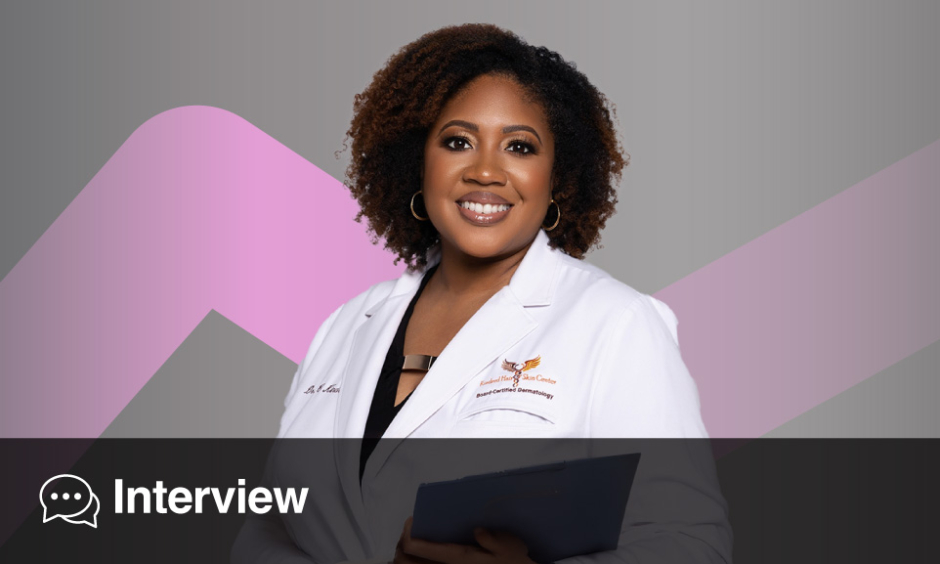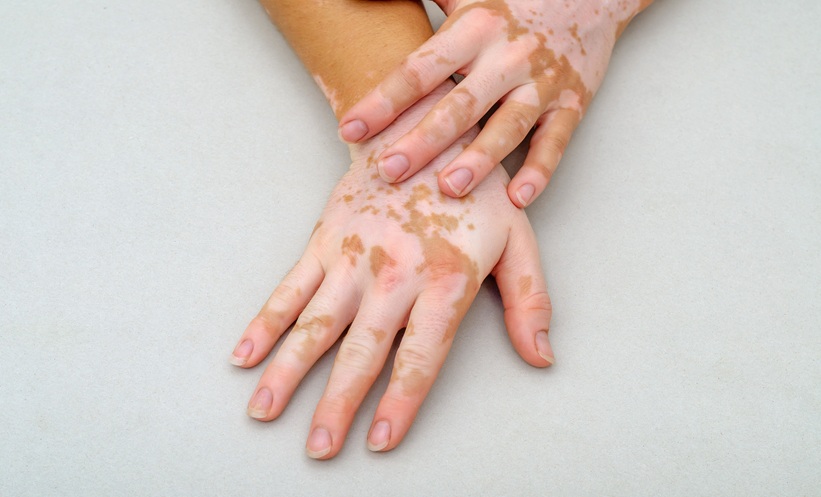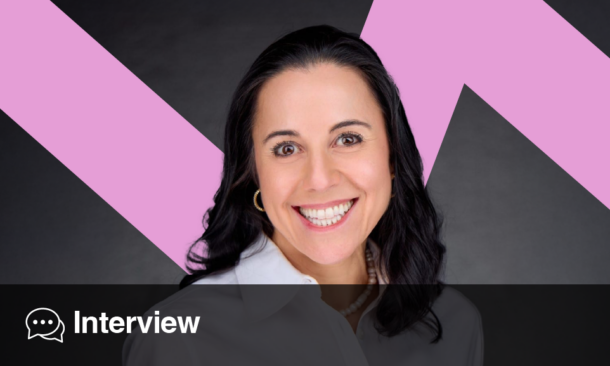Chesahna Kindred | Kindred Hair & Skin Center, Marriottsville, Maryland, USA
Citation: EMJ Dermatol. 2024;12[1]:112-116. https://doi.org/10.33590/emjdermatol/BTVU4842.
![]()
What led you to decide to pursue dermatology and, more specifically, focus on ethnic skin and hair loss?
With little exposure to dermatology in medical school, the answer to why we pursue dermatology is rarely straightforward. I was the type of medical student who liked every field in every rotation. I really enjoyed them… with the exception of ear, nose, and throat (ENT) because I cannot do mucus; that is my kryptonite! During my third year of medical school, I decided to pursue ophthalmology. In between 3rd and 4th year, I earned my Master of Business Administration (MBA) and was the third person in the history of the University of Cincinnati, Ohio, USA to earn an Doctor of Medicine/MBA dual degree. My advisor suggested that expose myself to a field of medicine not well covered in school. That meant dermatology and urology.
While I was getting my MBA at the College of Business, I did a couple of research projects in dermatology. When I returned to the College of Medicine, I completed my senior ophthalmology rotation and was bored to death: no offense ophtho! One of the dermatologists who co-authored one of my publications said: “Well, why don’t you look into dermatology?” So, in my senior year, I did a dermatology rotation and loved it. I felt like it combined what I loved about many other fields of medicine. I had no intentions of “focusing on ethnic skin” when I decided to pursue dermatology. I didn’t realise it was excluded from the mainstream curriculum.
I trained at Howard University, Washington D.C., USA, and they taught us on white skin, black skin, every skin; so it was not really a focus. I learned to be a dermatologist for everyone. However, I did choose to focus on hair loss. When I graduated from Howard University, what was considered standard for what we trained was a little bit ahead of what was offered in the Baltimore, Maryland area.
Then I did a project with a fellow Dermatologist, Yolanda Lenzy, Lenzy Dermatology, Chicopee, Massachusetts, USA. Her project was called ‘Project Hair’, where we did workshops for stylists. We completed two workshops together and I did one on my own. From there, stylists referred their patients to me. It snowballed to the point that I was the first dermatologist in the USA to have a full service in-house hair salon in a dermatology practice. It’s called PeterKINdred Hair and Scalp Wellness Center and was cofounded with Susan Peterkin, a stylist who attended the workshop I did on my own.
Recently, the stylist and I created a network called ‘S.T.R.A.N.D’, which stands for Stylists, Training, Researching, And Networking with Dermatologists. This is a network where dermatologists and stylists are members. Dermatologists train stylists in an intense 2-day course. If the stylists pass the exam, they become STRAND-certified. We have presented this at beauty shows and so on. It has really turned into something much bigger than I thought the day I decided to pursue dermatology.
You touched on the fact that you did an MBA to complement your medical degree. How do you think your business background has helped shape your approach to running the Kindred Hair and Skin Center, and being a leader within the field of dermatology?
Having my MBA helped me to know what I should know. Nowhere in my training, during high school, college, medical school, my intern year, or during residency, taught me about a balance sheet, cash flow, income statement, etc., which are common things that are important for business and leadership. It did not teach me the things to ask my accountant, or how to really manage debt and how to avoid debt. The MBA did that and also helped me to see that, and I know other physicians feel it, everything is set up for doctors to just become machines; to no longer practice the art of medicine, to take the care out of healthcare, and this is the ugly truth about healthcare right now.
When we turn everything over to the business side, we lose sight that money is not the only bottom line. The second bottom line is the patient’s health, and that’s helped me to resist falling prey to private equity or knowing how to work with private equity in a way that does not throw us as physicians under the bus. It has helped me to teach younger physicians how to start their practice without a loan, which I think is very key. If we start with a lot of debt, then we end up making some of the wrong decisions early on, and that really colours the legacy of our practices. I do not think physicians necessarily have to get a full MBA, but we most certainly, at the very least, should have some type of business course that helps us to be better prepared and better armed for the business side of medicine.
Your work at Howard University, an institution known for its focus on ethnic dermatology, sparked a passion for treating patients with skin of colour. In your experience, what are some of the most common misconceptions or gaps in understanding when it comes to treating skin of different ethnicities?
I want to emphasise that Howard University taught me to be a dermatologist. It did not teach me to be a dermatologist on White skin, or Black skin. It taught me to be a dermatologist so that when a patient comes in, I can recognise the skin disease. It doesn’t matter if the patient is White or Black or Latina, etc., I can recognise the difference between erythema dyschromicum perstans and melasma, I can recognise vitiligo in a White patient, and I can diagnose acanthosis nigricans versus lichen simplex chronicus. I can diagnose patients, and I am not biased because of the colour or misled because they have a different skin tone.
It really taught me to be what I think it truly means to be a dermatologist. So, there wasn’t a separation, and it wasn’t an extracurricular activity or a passion for treating skin of colour. The passion is for every dermatologist to fill that gap that may have been created by their curriculum, and I think more institutions should look at Howard University as the model. We’re trained in the USA but trained for the US; whereas the Howard University model did train us to do this. I really love that institution for that reason.
Now, there are a few misconceptions with ethnic skin. One that unfortunately still exists is that Black people do not feel pain or have a higher resistance to pain. This is the most ridiculous thing I have ever seen printed in black and white. I think they misconstrue sometimes a patient’s reaction to pain and interpret that that’s how painful something is, which is, as a physician, one of the worst things I think we could do. Another misconception is that redness or erythema is the only indicator of inflammation.
Another is that hyperpigmentation is cosmetic, and I wish that weren’t the case. For example, if we have a patient with acne, they want their skin to go back to normal, and not just a little bit. They want the acne gone, the redness gone, the scar gone, and the post-inflammatory hyperpigmentation gone.
Another misconception is that the patient is non-compliant. I see that in a lot of the discourse and dialogue on certain chat groups, etc. I think that probably has to come with maybe some cultural differences, and so we all, including me, have to be intentional by making sure we are connecting with our patients. Our patients are individuals, and our patients are the same, regardless of ethnicity, and I think that is one of the skills that was really ingrained in us at Howard University.
There have been studies highlighting how vitiligo can have a profound impact on mental health. Have you experienced this in your practice, and do you feel that the psychological burdens of dermatological conditions can sometimes be overlooked in modern medicine?
I think it is both. We overlook the psychological burdens, but more and more I’m seeing the psychological burdens of dermatologic conditions taken into account. Great examples of this are psoriasis and vitiligo.
At Howard University, I still remember, and it has coloured the way I treat my patients with vitiligo, but I still remember one patient in particular. She was of Indian descent and had segmental vitiligo on her abdomen and back. It was such an eye-opener to realise just how grave the diagnosis of vitiligo was; that she would not be able to get married if her future in-laws knew she had vitiligo. So, this was something we had to be mindful of, when her husband was there, versus when her future mother-in-law was there, etc. Generally, as physicians, if a patient brings someone in the room, it is understood that the patient wants that relative included in the discussion. However, we all had to make sure we knew exactly who it was she brought with her that day; whether it was on her side of the family, her immediate family such as her parents and siblings, or if it was her fiancé or fiancé’s siblings. It was a really big deal and we always paid attention when she was on a schedule because of the impact that it had.
Aside from that, for other diseases like psoriasis and atopic dermatitis, we are taking better account of whether or not it interrupts sleep, which I think we have not paid enough attention to. We are also taking better account of how the patient feels about their skin condition when they are not flaring, as we tend to focus on the flare. We now consider if they are having anxiety when their skin looks normal because they are worried about the next flare. This includes screening questions about depression and suicide. An important point is not simply excluding a patient from a clinical trial because they had suicidal ideation 20 years ago and none since. We are getting better, but we’re not there yet. The most important thing, I think, is to not call skin diseases frivolous or unimportant or cosmetic. Most things that are considered cosmetic by insurance companies are medical conditions that have psychological burdens on our patients.
As a specialist in alopecia areata (AA), could you talk about the status of treatments, such as platelet-rich fibrin matrix (PRFM)/ platelet-rich plasma (PRP) and what the future of AA treatment might look like in terms of the introduction of AI in clinical practice?
Before JAK inhibitors arrived, I would indeed use PRFM or PRP for AA, but the JAK inhibitors have really been a game changer. I no longer offer PRFM or PRP because usually I can get the patient to have meaningful, significant scalp hair regrowth with the medications.
For AI, we have been using it in our practice since 2020 and it’s just awesome. We use AI for hair density checks. We take a picture of the patient’s scalp using special software, and the software uses AI to calculate the hair density. We can all take photos and put before and after images side-by-side and confirm they are getting better a little bit, moderately, or significantly, etc. But we are still just eyeballing it. It’s the equivalent to me putting my hand against your forehead and saying: “I think you have a fever”, versus me using a thermometer. So, in our office, we call these hair density checks with AI ‘AI checks’. The AI check provides a precise number to track allowing me to determine if a patient is improving or worsening earlier than comparing before and after photos. It has been an awesome tool in my practice, and I recommend anyone who specialises in hair loss to consider one of these devices.
One of your clinical focuses has been on the unique challenges and presentations of skin cancer in melanin-rich skin, where signs of cancer can often be more subtle. Given our audience is primarily healthcare professionals, could you describe what are the most common differences you have seen in the presentation of skin cancer in this patient group?
Skin cancer is such an awesome topic when it comes to skin of colour. There is a misconception in the USA that sunscreen protects Black people from skin cancer. Data shows that skin cancer in Black people tends to occur in sun-protected areas instead of sun-exposed areas. In my 3 years training at Howard and over 200 skin cancer excisions, only one was a Black patient (it was basal cell carcinoma). The exception was cutaneous T cell lymphoma or mycosis fungoides. We had a few dozen cases of mycosis fungoides (mostly in Black people), but regarding melanoma, squamous cell carcinoma, and basal cell carcinoma, it was quite uncommon in skin of colour. And by skin of colour, I mean Black, Latin, Indian, Pakistani, Filipino, and Chinese, individuals, i.e. non-White individuals. On the other hand, skin cancer significantly burdened our White patients. This is when I’m going to say something controversial: Black people need to be more aware that they can get skin cancer; not broadly undergo annual skin checks. The energy should be put towards education and awareness. For example, Black people need to be aware that skin cancer can occur; and to monitor suspicious lesions on their feet, fingernails, and toenails. Campaigns should show photos of acral lentiginous. In contrast, for my White patients, it is most commonly in a sun-exposed area that could have been protected by sunscreen. National campaigns tend to focus on just this aspect of skin cancer.
So, one of the unique challenges is we do recommend sunscreen for everyone. For my White patients, it’s mostly because I want to prevent them from getting a skin cancer, whereas for my Black patients, it’s mostly for anti-aging purposes. Clearly, there’s some nuance here. Black individuals need to be more aware of skin cancer and the way it would look on their skin, and that’s where the energy needs to go, and I don’t see it going that direction enough. There is no quick phrase for that, at least I haven’t come up with a quick phrase for that slight, subtle difference. If we look at annual skin screenings, and I do skin checks all the time, it’s not high yield for our Black patients, but we need to make sure they know what’s normal, what’s not normal, and when to come in. That is the most common difference that I see on a regular basis in my patients when it comes to when it comes to skin cancer.
As a member of the Women’s Dermatological Society (WDS), what have you learnt from this role and how has it impacted your day-to-day practice?
The WDS is awesome, it is the first women’s group I ever came across in my training. When I was a resident at Howard, I was awarded their mentorship grant, and I used that to spend a week in New York shadowing Andrew Alexis, Weill Cornell Medicine, New York, USA. It was awesome to see how he practiced, and I picked up some tips for ways that he approached certain things. I also remember Valerie Callender, Howard University College of Medicine, Washington D.C., USA, sponsoring us to attend the WDS luncheons. What was great was that I saw women and men at the WDS and these luncheons are just legendary; everybody knows about the WDS luncheon.
Now, as a practising physician, I have no insecurities about being a woman in business, because in my training, I would be in a room with hundreds of women at the WDS, running their practices with excellence, including cutting-edge research, discovering things, and inventing things. So out of my training, by seeing members of the WDS just being themselves, I feel like it helped me to be a beast and not think that I shouldn’t be here because I’m a woman. I’ve never had imposter syndrome as a dermatologist because I’m a woman.
Could you talk about your current research projects and, as you look to the future, what are your key research goals?
My research goal is to increase the number of Black dermatologists who are principal investigators. When I was Chair of the dermatology section for the National Medical Association (NMA Dermatology), I had a bird’s eye view of what Black physicians were discussing. Topics included the lack of representation in clinical trials.
I tried to come up with a solution and I created the Research Committee run by the current NMA Dermatology Chair, Hope Mitchell, Mitchell Dermatology, Perrysburg, Ohio, USA. Since my tenure ended, I have made it more focused. Last year, I co-created Raven Clinical, and that is where we mentor a smaller number of Black physicians. We have five sites who all started with investigator-initiated trials. Now all the dermatologists currently have two trials. The goal is for each of them to have two trials for 2 years so that they learn how to be a principal investigator. The difference between this and a clinical research organisation is the goal of Raven Clinical is for the dermatologists to really know how to be a principal investigator.
Everyone in the clinical research world knows it’s really difficult to get into the clinical trials if you don’t have any experience. So, we really insulated these dermatologists with experience. The goal is that these five dermatologists will then mentor one or two dermatologists, so I’ll recruit the next 5–10 dermatologists, and then hopefully it will snowball from there. At the end of the day, the whole point is for patients to have medications that work for them and for every American to have a medication launched that works for them because it was proven in the clinical trial.








